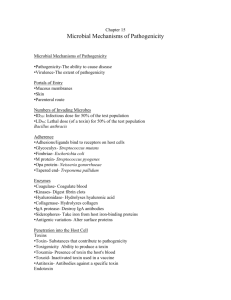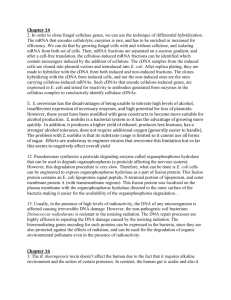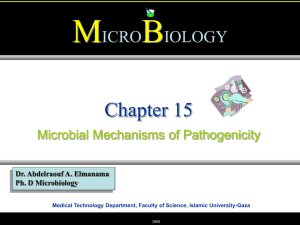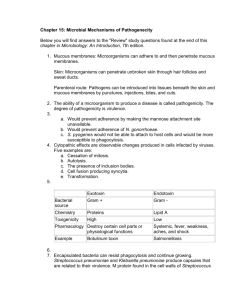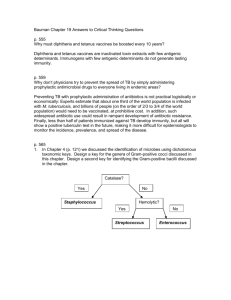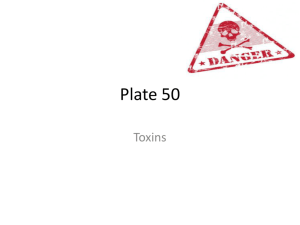General- pathogenesis . ppt
advertisement
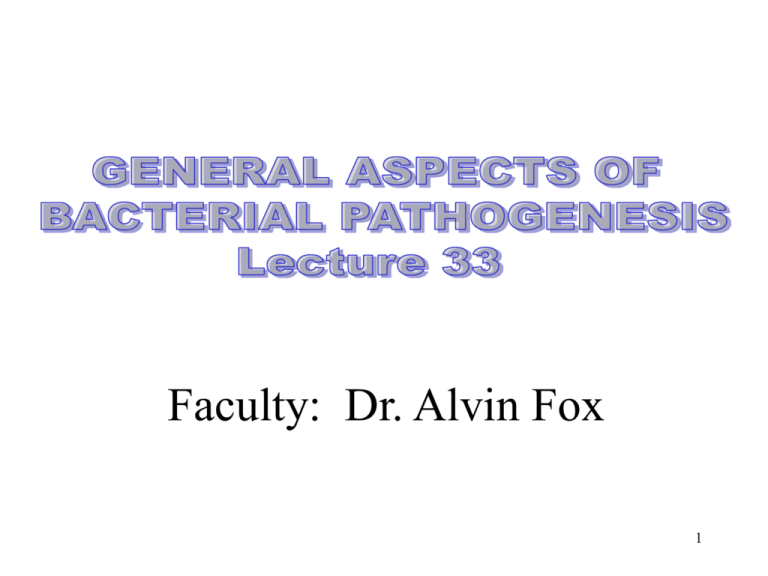
Faculty: Dr. Alvin Fox 1 Key Words Pathogen Transmission Outbreak, Epidemic, Pandemic Adhesion Normal flora Penetration Infection Invasiveness/spread Infectious diseases Extra/intra cellular pathogen Compromised host Exotoxin Opportunistic infection Endotoxin - non-specific immunity Nosocomial Specific immunity Koch’s postulates Autoimmunity Bioterrorism 2 Pathogenicity • virulence factors • number of initial organisms • immune status 3 Pathogens • The “usual” rate • Oubreak - local • Epidemic - regional/national • Pandemic – widespread (international) – infections “beyond the norm” 4 Koch's postulates • isolated – diseased not healthy people • growth – pure culture • induce disease – susceptible animals • re-isolated – susceptible animals 5 Opportunistic infections – normal flora – environment – often compromised individuals 6 Opportunists - normal flora • Skin – Staphylococcus aureus – Staphylococcus epidermidis – Propionibacterium acnes • Intestine – Bacteroides * high numbers – Enterobacteriaceae * low number 7 Opportunists - environment • • • • air water soil food 8 Opportunists • Community-acquired • Nosocomial - hospital 9 Transmission • airborne droplets • food • water • sexual contact 10 Host defenses • Gut – peristalsis – defecation • respiratory tract – ciliary action – coughing – sneezing • urogenital tract – urination 11 Adhesion BACTERIUM adhesin receptor EPITHELIUM 12 S. pyogenes F-protein lipoteichoic acid fibronectin 13 E. coli Fimbriae Flagella 14 E. coli fimbriae Type 1 mannose P galactose – glycolipids – glycoproteins 15 Penetration and spread Epithelium Blood stream Salmonella typhi Salmonella enteritidis Vibrio cholerae Gut lumen 16 Connective tissue destrction • Helps bacterial dissemination – collagenase – hyaluronidase 17 Extracellular pathogens • resistant to extra-cellular killing • killed on phagocytosis • resist killing –by avoiding internalization 18 Protein A inhibits phagocytosis Fc receptor immunoglobulin PHAGOCYTE Protein A BACTERIUM 19 M protein inhibits phagocytosis Complement fibrinogen M protein r peptidoglycan r r 20 Intracellular parasite Lysozome Bacteria Macrophage or neutrophil Phagosome No fusion Fusion Enter cytoplasm 21 Killing of intracellular parasite • Cell mediated immunity 22 Tissue Injury • exotoxins • endotoxins and non-specific immunity - no antigen • specific immunity - antigen 23 Exotoxins • proteins • usually enzymes • destroy cellular structures • destroy extracellular matrix 24 A-B toxins Cell surface Active Binding A B 25 • Diphtheria toxin and Pseudomonas exotoxin A – ADP-ribosylates elongation factor (EF2) – inhibits protein synthesis – kills cells, destroys tissues 26 Cholera toxin and E. coli labile toxin • ADP-ribosylation of regulator • adenylate cyclase activation • cyclic AMP • active ion and water secretion • diarrhea 27 Shiga toxin - shigellosis Shiga-like toxin – enterohemorrhagic E. coli • lyses 28S rRNA in ribosome • death of epithelial cells • poor water absorption • diarrhea 28 • Botulinum toxin – inhibits acetylcholine release – inhibits nerve impulses – muscles inactive –flacid paralysis • Tetanus toxin – inhibits glycine release – inactivates inhibitory neurons – muscles over-active – rigid paralysis 29 Exotoxins - extracellular matrix of connective tissue • Clostridium perfringens - collagenase • Staphylococcus aureus - hyaluronidase 30 Membrane damaging exotoxins • Proteases • Phospholipases • Detergent-like action 31 C. perfringens phospholipase • destroys blood vessels • stops influx inflammatory cells • creates anaerobic environment • allows growth of this strict anaerobe. 32 Exotoxins • Antibodies (anti-toxins) neutralize – vaccination 33 Endotoxin • Lipopolysaccharide - endotoxin • peptidoglycan -endotoxin-like action • cell envelope components • not proteins/enzymes 34 Septic shock • hypotension (tissue pooling of fluids) • disseminated intravascular coagulation • fever • lack of effective oxygenation • overall system failure 35 Endotoxins • • • • • • non-specific inflammation cytokine release complement activation B cell mitogens polyclonal B cell activators adjuvants 36 Specific immunity and immunopathology • chronic infection • tuberculosis • leprosy • syphilis • persisting bacterial remnants • autoimmunity 37 IgA proteases • help survival on external surfaces – H. influenzae – S. pneumoniae – N. gonorrhoeae – N. meningitidis 38 Bioterrorism • air – most common • no previous exposure – zoonoses • manifest initially – colds/flu-like – death or debilitation • recognition – clinically (e.g. common source clusters) – clinical microbiology – biodetection (environment) • future 39

